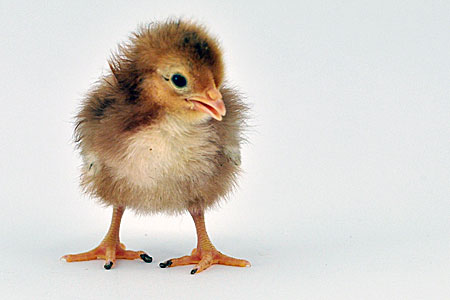
Cannibalism is the disagreeable habit chickens have of pecking one another until they draw blood. And then pecking some more. Chickens may engage in any one of six forms of cannibalism, varying by age and gender.
Toe Picking — Chicks
Toe picking is a common problem among chicks. It can occur in a brooder where chicks don’t have enough things to peck at. They may, for example, have trouble finding something to eat.
Maybe the feeder has a poor design or is too high, too far from the heat source, or too small for the number of chicks involved. Chicks looking for something to peck may end up pecking each others’, or even their own, toes. Toe picking also occurs where the brooder is so unclean that poop sticks to the chicks’ toes (as shown in the photo).
To encourage chicks to peck at feed instead of feet, sprinkle a little starter ration on a paper plate or in a similarly shallow container. Place the container close to (but not under) the heat source where the chicks can easily find it.
If toes are injured from picking, light the brooder with a red light. That way chicks can’t easily detect blood while the toes heal.
Feather Picking — Teenagers & Mature Chickens
Feather picking occurs most often among growing chickens that are just developing their full plumage coat. It is more common when the birds are crowded and frustrated.
It also occurs in chicks kept in a brooder with a hardware cloth floor. A wire mesh brooder floor offers no opportunity for normal scratch-and-peck behavior.
Evidence of feather picking is bare patches on a bird’s neck, breast, back, or below the vent. Newly emerging blood-filled feathers at the base of the tail are especially tantalizing.
In mature chickens, an infestation of external parasites can cause pecking. Lice and mites irritate the skin and feathers. In trying to relieve the itch, chickens peck at themselves. The resulting injured skin invites pecking by other chickens.
Hens that are missing feathers because of treading may have a hard time growing new feathers. Flock mates may keep pulling out the feathers that are trying to regrow.
Tail Pulling — Teenagers
Tail-feather pulling is a type of feather picking. This form of cannibalism in chickens is easy to spot. A picked-on chicken lacks tail feathers. And the long feathers litter the coop floor.
Tail pulling is especially common in growing birds. Triggers include being too crowded, too hot, frustrated, or bored.
If you keep different poultry species together, tail pulling may not necessarily be initiated by the chickens. Guinea fowl, for example, are more active and somewhat more aggressive than most chicken breeds. They may pull out the tail feathers of chickens to obtain fiber, to obtain protein, or just for fun.
Head Picking — Roosters & Birds in Adjoining Cages
Cannibalistic head picking may occur when one bird is going through a hard molt, leaving the head and neck skin bare. Another pecking trigger is a bloody comb or bloody wattles, which may be the result of a fight or frostbite.
Two roosters or two hens housed in adjoining cages may pick each other’s heads. This situation may occur in show birds during coop training prior to an exhibition.
The solution is to space cages far enough apart to prevent picking. Cardboard or a feed sack wedged between cages is not always the best answer, if it reduces air circulation in warm weather.
Vent Picking — Pullets
Vent picking can start if nest boxes get too much light. It often occurs among pullets just starting to lay.
It usually starts after a pullet tears tissue or prolapses while passing an egg that’s larger than her maturing equipment is ready to handle. The protruding tissue attracts other chickens to start picking. Locating nests in a darkened area of the coop should prevent this type of picking.
Vent picking sometimes occurs when one chicken wanders beneath a roost where another chicken is resting. The lower chicken takes an exploratory peck, then another and another. To avoid this attraction, place the lowest perch at least 18 inches above the floor.
Egg Eating — Hens
Egg eating occurs when not enough nests are provided, nests are too brightly lit, housing is too light in general, or hens are crowded and bored. It often occurs as a result of eggs breaking in the nest.
Maybe eggs aren’t collected often, have soft or thin shells, or become cracked because of inadequate nesting material. Once chickens find out how good eggs taste, they purposely break them to eat them.
To discourage other-than-laying activities in the nests, darken nests by tacking or stapling curtains that hang across the nest front. Pin up one corner for a few days, until the hens learn how to get behind the curtains.
And that’s today’s news from the Cackle Coop.
Gail Damerow is author of The Chicken Health Handbook.

